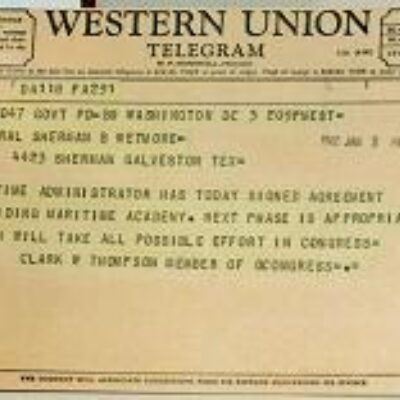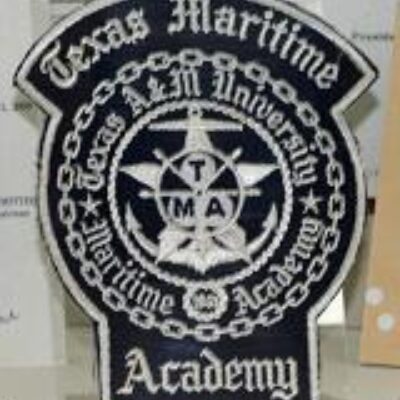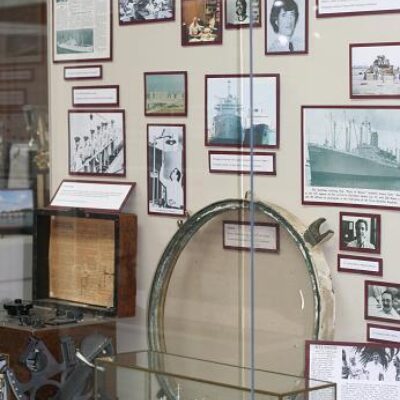
This exhibit, a joint effort of the Rosenberg Library and Texas A&M University at Galveston, commemorated the dedication and vision that led to the establishment of a merchant marine training academy at the Port of Galveston. Visitors were able to see dozens of artifacts, photographs, and other memorabilia from the school’s five-decade history. In addition, an oversized chronological timeline highlighted the individuals and events responsible for the development and growth of the institution.
The idea of founding a maritime academy on Galveston Island originated at a banquet held at the Hotel Galvez in 1958. It was May 21st, the day before National Maritime Day, and Rear Admiral Walter C. Ford, deputy administrator of the federal Maritime Administration, was the guest of honor and keynote speaker. Members of the Galveston Chamber of Commerce, the Galveston Propeller Club, and other local organizations attended the annual event. It was through conversations at this function that the Galveston Chamber of Commerce appointed a committee to create a maritime academy on the Texas coast.

The determination of the investigative committee led to a legislative reform that would allow a maritime academy to seek both state and federal funding. The Texas Maritime Academy — officially renamed Texas A&M University at Galveston in 1979 — might not have lasted had it not been for the relentless efforts of numerous individuals including Captain Bennett M. Dodson, U.S.N. (Ret.), Rear Admiral Sherman B. Wetmore, U.S.N.R. (Ret.), James Earl Rudder, Emmett O. Kirkham, William A. Clayton, and Dr. Jack K. Williams.

One of the most interesting items that was on display was a letter from Edward Schreiber, President of the Galveston Chamber of Commerce, to Admiral Walter Ford dated May 22, 1958 (one day after the Maritime Day Banquet). In it, Schreiber thanked the Admiral for his remarks and expressed his wish that the possibility of establishing a maritime academy at Galveston be seriously considered.
On January 3, 1962, Captain Sherman Wetmore, chairman of the Galveston Maritime Committee, received a Western Union telegram notifying him that the U.S. Maritime Administration had approved the establishment of an academy on Galveston Island. The Rosenberg Library Special Collections has this original document in their archives, and a copy of it is also included in the exhibit.

Twenty-three days later, the Texas Governor Price Daniel and Texas A&M University President James Earl Rudder signed the agreement authorizing the opening of the Texas Maritime Academy.
The Texas Maritime Academy then made momentous progress when Mr. George P. Mitchell generously donated the 100-acre Mitchell Campus on Pelican Island to the school in honor of his parents. The Mitchell Campus was ready for occupancy in 1971. Landscaped with only patches of brush, the campus originally consisted of the berth for the Texas Clipper, an engineering building, and the academic building (called Admin and, later, Kirkham Hall.) From these humble beginnings, the institution has added the Northen Student Center, three dorms, two private dormitories, a physical plant, the Jack K. Williams Library, the Physical Education Facility, 156 acres of wetlands on West Galveston Island, the Offat’s Bayou campus (Waterfront Campus on Teichman Road), the state-of-the-art Engineering Building, the Sea Aggie Center adjacent to the Mitchell Campus, and has recently broken ground for the new Science Building. The school has also received a $2 million dollar gift from George Mitchell to expand its maritime fisheries research.
The Texas Maritime Academy found a generous friend and benefactor in Mary Moody Northen. Ms. Northen donated a great deal of time and money to aid the school during its early days. The student center on campus is named in her honor.
Another Galvestonian, Senator A.R. “Babe” Schwartz, fought not only to establish a maritime academy in Galveston but also to make it a designated college under the Texas A&M University system. Schwartz battled in the state legislature to secure both state and federal funding for the school.

Dr. Sammy Ray is a living legend at Texas A&M at Galveston. A pioneer in marine biology, and one the world’s foremost experts on oysters, Dr. Ray has been a presence on campus since the early days at Fort Crockett. Fort Crockett was a WWII military training base, and Building 311 was designated as the campus headquarters for the first class of cadets to enroll at the Texas Maritime Academy in 1962.
Displayed at the entrance to the exhibit was the original wooden sign for Fort Crockett’s Building 311. The first catalog of courses for the 1962 – 1963 academic year was also on display. The exhibit included photos of the 1964 dedication of the Fort Crockett Campus, and the 1971 dedication of the Mitchell Campus on Pelican Island. Relics from Texas Clipper I, the school’s first training vessel, were displayed. Even an autographed book by famed underwater explorer Jacques Cousteau was on exhibit.

TAMUG has appeared in the U.S. News & World Report list of the top-ten colleges and universities in the West as well as been named among the top 500 colleges and universities in Time magazine’s Princeton Review.
The school has expanded from its original curriculum which offered one degree program, Marine Sciences, to offering degrees in Marine Biology, Marine Fisheries, Marine Sciences, Ocean and Coastal Resources, Marine Engineering Technology, Maritime Systems Engineering, Maritime Administration, Marine Environmental Law & Policy, Marine Transportation, Maritime Studies, and a Masters of Marine Resources Management.